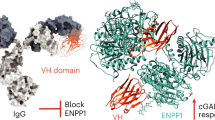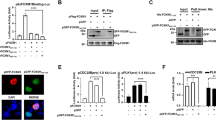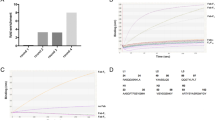Abstract
We have isolated several peptides from random peptide phage display libraries that specifically recognize the cell cycle regulatory transcription factor E2F and inhibit DNA binding of E2F/DP heterodimers (E2F-1, E2F-2, E2F-3, E2F-4 or E2F–5, and DP-1). The inhibitory efficiency could be strongly enhanced by generating branched tetravalent molecules. To analyse the biological consequences of peptide-mediated E2F inhibition, we fused two of these branched molecules to a cell-penetrating peptide derived from the HTV-Tat protein. Incubation of human tumor cells with these branched Tat-containing peptides led to an inhibition of cell proliferation and induction of apoptosis. These results provide new insights into the function of E2F and further validate E2F as a potential therapeutic target in proliferative diseases.
This is a preview of subscription content, access via your institution
Access options
Subscribe to this journal
Receive 50 print issues and online access
$259.00 per year
only $5.18 per issue
Buy this article
- Purchase on Springer Link
- Instant access to full article PDF
Prices may be subject to local taxes which are calculated during checkout









Similar content being viewed by others
References
Ahlborg N . (1995). J. Immunol. Methods, 179, 269–275.
Bandara LR, Buck VM, Zamanian M, Johnston LH and La Thangue NB . (1993). EMBO J., 12, 4317–4324.
Bandara LR, Girling R and La Thangue NB . (1997). Nat. Biotechnol., 15, 896–901.
Beijersbergen RL, Kerkhoven RM, Zhu L, Carlee L, Voorhoeve PM and Bernards R . (1994). Genes Dev., 8424, 2680–2690.
Buchkovich K, Duffy LA and Harlow E . (1989). Cell, 58, 1097–1105.
Buck V, Allen KE, Sorensen T, Bybee A, Hijmans EM, Voorhoeve PM, Bernards R and La TNB . (1995). Oncogene, 11, 31–38.
Cartwright P, Muller H, Wagener C, Holm K and Helin K . (1998). Oncogene, 17, 611–623.
Chellappan SP, Hiebert S, Mudryj M, Horowitz JM and Nevins JR . (1991). Cell, 65, 1053–1061.
Chen PL, Scully P, Shew JY, Wang JYJ and Lee WH . (1989). Cell, 58, 1193–1198.
Delia D, Goi K, Mizutani S, Yamada T, Aiello A, Fontanella E, Lamorte G, Iwata S, Ishioka C, Krajewski S, Reed JC and Pierotti MA . (1997). Oncogene, 14, 2137–2147.
DeCaprio JA, Ludlow JW, Lynch D, Furukawa Y, Griffin J, Piwnica-Worms, H, Huang CM and Livingston DM . (1989). Cell, 58, 1085–1095.
Dignam JD, Lebovitz RM and Roeder RG . (1983). Nucl. Acids Res., 11, 1475–1489.
Doorbar J and Winter G . (1994). J. Mol. Biol., 244, 361–369.
Endresen PC, Prytz PS and Aarbakke J . (1995). Cytometry, 20, 162–171.
Fabbrizio E, Le Cam L, Polanowska J, Kaczorek M, Lamb N, Brent R and Sardet C . (1999). Oncogene, 18, 4357–4363.
Fan J and Bertino JR . (1997). Oncogene, 14, 1191–1200.
Fawell S, Seery J, Daikh Y, Moore C, Chen LL, Pepinsky B and Barsoum J . (1994). Proc. Natl. Acad. Sci. USA, 91, 664–668.
Field SJ, Tsai FY, Kuo F, Zubiaga AM, Kaelin Jr WG, Livingston DM, Orkin SH and Greenberg ME . (1996). Cell, 85, 549–561.
Fields GB and Noble RL . (1990). Int. J. Pept. Protein Res., 35, 161–214.
Furukawa Y, Nishimura N, Satoh M Endo H, Iwase S, Yamada H, Matsuda M, Kano Y and Nakamura M . (2002). J. Biol. Chem., 30, 30.
Gaubatz S, Wood JG and Livingston DM . (1998). Proc. Natl. Acad. Sci. USA, 95, 9190–9195.
Griffiths AD, Williams SC, Hartley O, Tomlinson IM, Waterhouse P, Crosby WL, Kontermann RE, Jones PT, Low NM, Allison TJ . (1994). EMBO J., 13, 3245–3260.
Helin K, Lees JA, Vidal M, Dyson N, Harlow E and Fattaey A . (1992). Cell, 70, 337–350.
Helin K, Wu CL, Fattaey AR, Lees JA, Dynlacht BD, Ngwu C and Harlow E . (1993). Genes Dev., 7, 1850–1861.
Herrmann M, Lorenz HM, Voll R, Grunke M, Woith W and Kalden JR . (1994). Nucleic Acids Res., 22, 5506–5507.
Irwin M, Marin MC, Phillips AC, Seelan RS, Smith DI, Liu W, Flores ER, Tsai KY, Jacks T, Vousden KH and Kaelin Jr WG (2000). Nature, 407, 645–648.
Ishizaki J, Nevins JR and Sullenger BA . (1996). Nat. Med., 2, 1386–1389.
Ivey-Hoile M, Conroy R, Huber HE, Goodhart PJ, Oliff A and Heimbrook D.C . (1993). Mol. Cell. Biol., 13, 7802–7812.
Kaelin WGJ, Krek W, Sellers WR, DeCaprio JA, Ajchenbaum F, Fuchs CS, Chittenden T, Li Y, Farnham PJ, Blanar MA, Livingston DM and Flemington EK . (1992). Cell, 70, 351–364.
Krek W, Livingston DM and Shirodkar S (1993). Science, 262, 1557–1560.
Krek W, Xu G and Livingston DM . (1995). Cell, 83, 1149–1158.
Lam EW and Watson RJ . (1993). EMBO J., 12, 2705–2713.
Lees JA, Saito M, Vidal M, Valentine M, Look T, Harlow E, Dyson N and Helin K . (1993). Mol. Cell. Biol., 13, 7813–7825.
Liu N, Lucibello FC, Körner K, Wolfraim LA, Zwicker J and Müller R . (1997). Nucl. Acids Res., 25, 4915–4920.
Loughran O and La Thangue NB . (2002). Curr. Biol., 12, R377.
Mittnacht S and Weinberg RA . (1991). Cell, 65, 381–393.
Morkel M, Wenkel J, Bannister AJ, Kouzarides T and Hagemeier C . (1997). Nature, 390, 567–568.
Muller H and Helin K . (2000). Biochim. Biophys. Acta, 1470, M1–M12.
Nevins JR . (2001). Hum. Mol. Genet., 10, 699–703.
Phillips AC and Vousden KH . (2001). Apoptosis, 6, 173–182.
Santoni-Rugiu E, Duro D, Farkas T, Mathiasen IS, Jaattela M, Bartek J and Lukas J . (2002). Oncogene, 21, 6498–6509.
Sardet C, Vidal M, Cobrinik D, Geng Y, Onufryk C, Chen A and Weinberg RA . (1995). Proc. Natl. Acad. Sci. USA, 92, 2403–2407.
Scott JK and Smith GP . (1990). Science, 249, 386–390.
Smith DB and Johnson KS . (1988). Gene, 67, 31–40.
Stiewe T and Putzer BM . (2000). Nat. Genet., 26, 464–469.
Tam JP and Zavala F . (1989). J. Immunol. Methods, 124, 53–61.
Tao Y, Kassatly RF, Cress WD and Horowitz JM . (1997). Mol. Cell. Biol., 17, 6994–7007.
Trimarchi JM, Fairchild B, Verona R, Moberg K, Andon N and Lees JA . (1998). Proc. Natl. Acad. Sci. USA, 95, 2850–2855.
Vairo G, Livingston DM and Ginsberg D . (1995). Genes Dev., 9, 869–881.
Vives E, Brodin P and Lebleu B . (1997). J. Biol. Chem., 272, 16010–16017.
Wu CL, Classon M, Dyson N and Harlow E . (1996). Mol. Cell. Biol., 16, 3698–3706.
Yamasaki L, Jacks T, Branson R, Goillot E, Harlow E and Dyson NJ . (1996). Cell, 85, 537–548.
Zwicker J, Lucibello FC, Wolfraim LA, Gross C, Truss M, Engeland K and Müller R . (1995). EMBO J., 14, 4514–4522.
Zwicker J and Müller R . (1996). Progress in Cell Cycle Research, Vol. 1. Meijer L, Guidet S, Tung HYL (eds). Plenum Press: New York, pp. 91–99.
Acknowledgements
We thank Marylou Zuzarte for FACS analyses and Dr M Krause (IMT) for oligonucleotide and peptide synthesis. This work was supported by a grant from the Deutsche Forschungsgemeinschaft to REK (SFB 397) and the Dr Mildred Scheel Stiftung für Krebsforschung to RM.
Author information
Authors and Affiliations
Corresponding author
Rights and permissions
About this article
Cite this article
Montigiani, S., Müller, R. & Kontermann, R. Inhibition of cell proliferation and induction of apoptosis by novel tetravalent peptides inhibiting DNA binding of E2F. Oncogene 22, 4943–4952 (2003). https://doi.org/10.1038/sj.onc.1206495
Received:
Revised:
Accepted:
Published:
Issue Date:
DOI: https://doi.org/10.1038/sj.onc.1206495
Keywords
This article is cited by
-
The broken cycle: E2F dysfunction in cancer
Nature Reviews Cancer (2019)
-
Established and new mouse models reveal E2f1 and Cdk2 dependency of retinoblastoma, and expose effective strategies to block tumor initiation
Oncogene (2012)
-
E2F-1 as an anticancer drug target
Oncology Reviews (2009)



